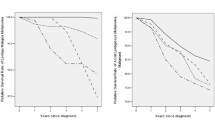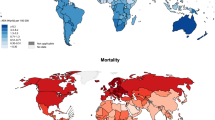Abstract
Background. A statistical investigation was conducted of Japanese melanoma patients who had been registered by the Prognosis and Statistical Investigation Committee of the Japanese Skin Cancer Society. The data were obtained from 24 main medical institutions in Japan in the period 1987 to 1996. The patients were classified into two chronological groups; group A, 535 patients registered from 1987 to 1991; and group B, 639 patients registered from 1992 to 1996. As the preliminary data for group A has been reported previously (Gann Monograph on Cancer Research 43), in this report, the survival data of group B were assessed, and compared with the data for group A.
Methods. The data analyzed included age, sex, anatomical distribution, clinical features of primary lesions, Clark's subtype, tumor thickness, Clark's level, disease stage, and treatment. The survival rate was assessed by the Kaplan-Meier method, and the significance of differences was determined with the log-rank test. In addition, the results of a nationwide survey of various types of skin malignancies, obtained from 101 medical institutions in Japan between 1987 and 1996, were analyzed.
Results. The nationwide survey revealed that the number of patients with malignant melanoma showed a steady increase during the period 1987–1996 in Japan. It is noteworthy that the numbers of actinic keratoses, a type of early squamous cell carcinoma in situ, showed a steep increase in recent years. Results revealed in our study of the melanoma registry for the period 1987–1996 were as follows: (1) the male-to-female ratio was 1 to 1.06, (2) the survival rate of female patients was higher than that of male patients (10-year survival in group B: female, 71.6% vs male, 55.9%), (3) the commonest site of melanoma in both sexes was the sole of the foot, (4) with respect to Clark's subtype, acral lentiginous melanoma was commonest, accounting for about half of all melanomas, (5) nodular melanoma showed the worst prognosis among the subtypes, (6) patients in stage IIIB and stage IV had an unfavorable outcome, with 10-year survivals of less than 50% and less than 10%, respectively, (7) Clark's level of invasion, as well as Breslow's tumor thickness of the primary lesions, were confirmed to be important prognostic factors, and (8) prophylactic lymph node dissection in stage II and IIIA and chemotherapy in stage IV seemed to have limited effect on the prognosis.
Conclusion. The prognosis of advanced melanoma is poor, as it is highly resistant to chemotherapy. Thus, to improve the prognosis, early detection is mandatory, and this is possible because this neoplasm appears as a distinctive pigmented lesion on the skin.
Similar content being viewed by others
Author information
Authors and Affiliations
Consortia
Additional information
Received: January 23, 2001
About this article
Cite this article
Ishihara, K., Saida, T., Yamamoto, A. et al. Updated statistical data for malignant melanoma in Japan. Int J Clin Oncol 6, 109–116 (2001). https://doi.org/10.1007/PL00012091
Issue Date:
DOI: https://doi.org/10.1007/PL00012091




